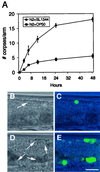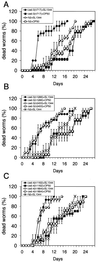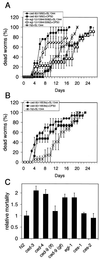Programmed cell death mediated by ced-3 and ced-4 protects Caenorhabditis elegans from Salmonella typhimurium-mediated killing
- PMID: 11226309
- PMCID: PMC30208
- DOI: 10.1073/pnas.041613098
Programmed cell death mediated by ced-3 and ced-4 protects Caenorhabditis elegans from Salmonella typhimurium-mediated killing
Abstract
Programmed cell death (PCD) in mammals has been implicated in several disease states including cancer, autoimmune disease, and neurodegenerative disease. In Caenorhabditis elegans, PCD is a normal component of development. We find that Salmonella typhimurium colonization of the C. elegans intestine leads to an increased level of cell death in the worm gonad. S. typhimurium-mediated germ-line cell death is not observed in C. elegans ced-3 and ced-4 mutants in which developmentally regulated cell death is blocked, and ced-3 and ced-4 mutants are hypersensitive to S. typhimurium-mediated killing. These results suggest that PCD may be involved in the C. elegans defense response to pathogen attack.
Figures



References
-
- Aballay A, Yorgey P, Ausubel F M. Curr Biol. 2000;10:1539–1542. - PubMed
-
- Kurz C L, Ewbank J J. Trends Microbiol. 2000;8:142–144. - PubMed
-
- Labrousse A, Chauvet S, Couillault C, Leopold Kurz C, Ewbank J J. Curr Biol. 2000;10:1543–1545. - PubMed
-
- O'Quinn, A. L., Wiegand, E. M. & Jeddeloh, J. A. (2000) Cell. Microbiol., in press. - PubMed
Publication types
MeSH terms
Substances
Grants and funding
LinkOut - more resources
Full Text Sources
Other Literature Sources
Molecular Biology Databases

